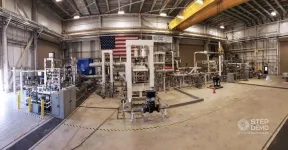(Press-News.org) Researchers at Baylor College of Medicine and collaborating institutions have discovered that a protein called hnRNPM helps protect the integrity of the process cells use to make proteins. hnRNPM works by preventing the cell from making mistakes while it is putting together the different components leading to newly produced proteins. In cancer cells, loss of hnRNPM triggers an interferon immune response, suggesting that this protein may hold clinical promise. The findings appeared in Molecular Cell.
“Synthesizing a protein is like putting together the different parts of a machine. If during the assembly process parts that do not belong are incorporated into the machine, the final product would not fulfill its intended function, disturbing the normal workings of the cell and potentially leading to disease,” said co-corresponding author Dr. Chonghui Cheng, professor of the Lester and Sue Smith Breast Center, molecular and human genetics and molecular and cellular biology at Baylor. “Despite the many opportunities for such mistakes, cells make proteins highly accurately and precisely. Here we investigated what helps cells maintain the integrity of this vital process.”
When a cell needs to synthesize a protein, it begins by getting the instructions from the corresponding gene in the DNA. Imagine a necklace with beads separated by empty pieces of the string that threads them together as an analogy for the DNA molecule carrying the instructions to make a protein. The beads represent the exons, the segments of a DNA molecule containing the information coding for the protein of interest. The string between beads represents introns, DNA segments separating the exons. Introns do not code for the protein itself, they help guide the process that regulates gene expression.
To make a functional protein, the cell first transcribes the DNA information contained in exons and introns into a pre-mRNA molecule. Continuing with the analogy, the cell makes a pre-mRNA necklace with beads (exons) interspaced with string (introns). Next, from the pre-mRNA necklace the cell makes an mRNA necklace by splicing together the beads leaving out the string (introns) in between. This mRNA is finally translated into a functional protein.
The researchers investigated how cells prevented errors that could occur during the step in which exons are spliced together, which could lead to abnormal mRNA molecules. They looked into splice sites, the segments that mark the location for the splicing of exons.
Pseudo splice sites and cryptic splicing
“The human genome has introns that are significantly longer than exons. These long introns contain numerous small segments, called pseudo splice sites, that are highly similar to the known correct splice sites,” said Cheng, a member of Baylor’s Dan L Duncan Comprehensive Cancer Center. “If pseudo splice sites are used instead of the correct splice sites during protein synthesis, the resulting mRNA will contain the wrong instructions – cryptic splicing – that could alter normal cell function.”
The researchers discovered that despite the presence of many pseudo splice sites, RNA splicing occurs accurately and precisely thanks to the RNA-binding protein hnRNPM. They discovered this by developing a bioinformatic pipeline that nominates cryptic sequences from datasets of RNA sequences.
“We found that hnRNPM preferentially binds to introns at regions containing pseudo splice sites,” said first author Dr. Rong Zheng, a graduate student in the Cheng lab while she was working on this project. “Their binding prevents or blocks the use of these splice sites when synthesizing RNA molecules, preventing cryptic splicing and therefore maintaining the integrity of the process.”
The team also discovered that in the absence of hnRNPM, cryptic splicing can form double stranded RNA (dsRNA), which is known to trigger interferon immune responses. “Tumors with low hnRNPM show increased cryptic splicing, interferon immune responses and immune infiltration,” Cheng said. “This finding suggests that inhibiting hnRNPM or enhancing the splicing of dsRNA-forming cryptic exons could represent innovative methods to activate immunity in patients with cancer.”
Other contributors to this work include Mikayla Dunlap, Georg O.M. Bobkov, Carlos Gonzalez-Figueroa, Khushali J. Patel, Jingyi Lyu, Samuel E. Harvey, Tracey W. Chan, Giovanni Quinones-Valdez, Mudra Choudhury, Charlotte A. Le Roux, Mason D. Bartels, Amy Vuong, Ryan A. Flynn, Howard Y. Chang, Eric L Van Nostrand and co-corresponding author Xinshu Xiao. The authors are affiliated with one of the following institutions: Baylor College of Medicine, University of California – Los Angeles, Stanford University School of Medicine.
This research was supported in part by grants from NIH (R35-CA209919, R01CA262686, R01AG078950 and R35GM131876) and cancer research scholarships from the Cancer Prevention Research Institute of Texas Scholars (RR200040 and RR160009).
###
END
hnRNPM, a guardian of the integrity of cellular protein production
2024-05-29
ELSE PRESS RELEASES FROM THIS DATE:
Children often exposed to problematic click bait during YouTube searches
2024-05-29
ANN ARBOR, Mich. – When a child peruses YouTube, the content recommended to them is not always age appropriate, a new study suggests.
Researchers mimicked search behaviors of children using popular search terms, such as memes, Minecraft and Fortnite, and captured video thumbnails recommended at the end of each video.
Among the 2,880 thumbnails analyzed, many contained problematic click bait, such as violence or frightening images, according to the Michigan Medicine led research in JAMA Network Open.
“Children spend a significant amount of time on free video sharing platforms that ...
Modular, scalable hardware architecture for a quantum computer
2024-05-29
CAMBRIDGE, MA — Quantum computers hold the promise of being able to quickly solve extremely complex problems that might take the world’s most powerful supercomputer decades to crack.
But achieving that performance involves building a system with millions of interconnected building blocks called qubits. Making and controlling so many qubits in a hardware architecture is an enormous challenge that scientists around the world are striving to meet.
Toward this goal, researchers at MIT and MITRE have demonstrated a scalable, modular hardware platform that ...
Landmark study is step towards energy-efficient quantum computing in magnets
2024-05-29
Researchers from Lancaster University and Radboud University Nijmegen have managed to generate propagating spin waves at the nanoscale and discovered a novel pathway to modulate and amplify them.
Their discovery, published in Nature, could pave the way for the development of dissipation free quantum information technologies. As the spin waves do not involve electric currents these chips will be free from associated losses of energy.
The rapidly growing popularity of artificial intelligence comes with an increasing desire for fast and energy efficient computing devices and calls for novel ...
Grow the skin you’re in: in vivo generation of chimeric skin grafts
2024-05-29
Researchers from Tokyo Medical and Dental University (TMDU) find that donor keratinocytes injected into mouse embryos form sheets of epidermis that can be used as autologous skin grafts
Tokyo, Japan – Skin grafting is an essential procedure used to treat severe skin wounds. In the case of extensive wounds, however, it can be challenging to harvest enough donor skin, and generating artificial skin substitutes that include hair follicles and sweat glands and can engraft on deep wounds has not been successful. Now, researchers from Japan report a new way to “grow your own” donor skin that could help improve the success of skin graft generation.
In a study published last ...
BGU researchers and colleagues discover therapeutic potential of increasing MIF protein levels as a novel approach for treating amyotrophic lateral sclerosis (ALS)
2024-05-29
BEER-SHEVA, Israel, May 29, 2024 – A recent collaborative research endeavor, published in the prestigious Cell Press journal Cell Reports Medicine, highlights a promising therapeutic avenue for amyotrophic lateral sclerosis (ALS). Led by researchers from Ben-Gurion University of the Negev in conjunction with counterparts from Germany, the USA, and Canada, the study delves into the potential of augmenting macrophage migration inhibitory factor (MIF) protein levels as a novel approach to tackling ALS.
ALS, often referred to as Lou Gehrig's disease, is a devastating neurodegenerative condition characterized by the progressive loss of motor neurons, leading to muscle ...
War magnifies politicians’ gendered behavior, public biases, research finds
2024-05-29
Women’s participation in politics is essential to advancing women’s rights and contributes to countries’ overall stability and economic prosperity. According to a 2023 report by UN Women and the Inter-Parliamentary Union, one-fourth of parliamentary positions worldwide are held by women. Although current representation is still far from equal, it represents a significant increase over the last 20 years.
However, a new paper from Washington University in St. Louis — published ...
International experts reach consensus on the labeling of spatial neglect
2024-05-29
East Hanover, NJ, May 29, 2024 — A consensus has been achieved by an international team of rehabilitation researchers and clinicians on the standardized labeling of spatial neglect, a common disorder following neurological injury, which is characterized by a lack of awareness or response to objects or stimuli on the side opposite a brain lesion. The panel reached a 75% consensus to adopt "spatial neglect" as the standard term for the disorder.
The consensus paper, titled “An International and ...
Gaps in transition from pediatric to adult care for individuals living with sickle cell disease associated with more hospital visits
2024-05-29
(WASHINGTON, May 29, 2024) – Individuals living with sickle cell disease (SCD) who experience a delay of more than six months in transitioning from pediatric to adult care are twice as likely to be hospitalized compared to those who transition in less than two months, according to a study published in Blood Advances.
SCD is the most common inherited red blood cell disorder in the United States, affecting an estimated 100,000 people. According to the Centers for Disease Control and Prevention, SCD affects one out of every 365 Black or African American births and one out of every 16,300 ...
STEP Demo supercritical CO2 pilot plant generates electricity for the first time
2024-05-29
SAN ANTONIO — May 29, 2024 —The Supercritical Transformational Electric Power (STEP) Demo pilot plant has generated electricity for the first time using supercritical carbon dioxide (sCO2) power cycles. The $169 million, 10-megawatt sCO2 facility at Southwest Research Institute (SwRI) in San Antonio is demonstrating next-generation power production technology in a project led by GTI Energy in collaboration with SwRI, GE Vernova, the U.S. Department of Energy/National Energy Technology Laboratory (U.S. DOE/NETL), and several industry participants.
“The impact of demonstrating that the sCO2 technology works cannot be overstated,” said SwRI Project Manager Dr. Jeff ...
Risky path to meeting climate targets for Stockholm
2024-05-29
The Swedish capital Stockholm aims to capture more carbon dioxide than is emitted by 2030. Therefore, the city is investing in new technology at a combined heat and power plant. But it is a strategy that has been adopted without sufficient discussion of the risks, says researchers at Linköping university, Sweden.
“Stockholm has a very ambitious climate policy. But there’s also been a kind of resignation. This new technology has appeared to offer the promise of a solution. And that’s perhaps why there’s been no critical discussion at all,” says researcher Alexander Olsson at the Department of Thematic ...





